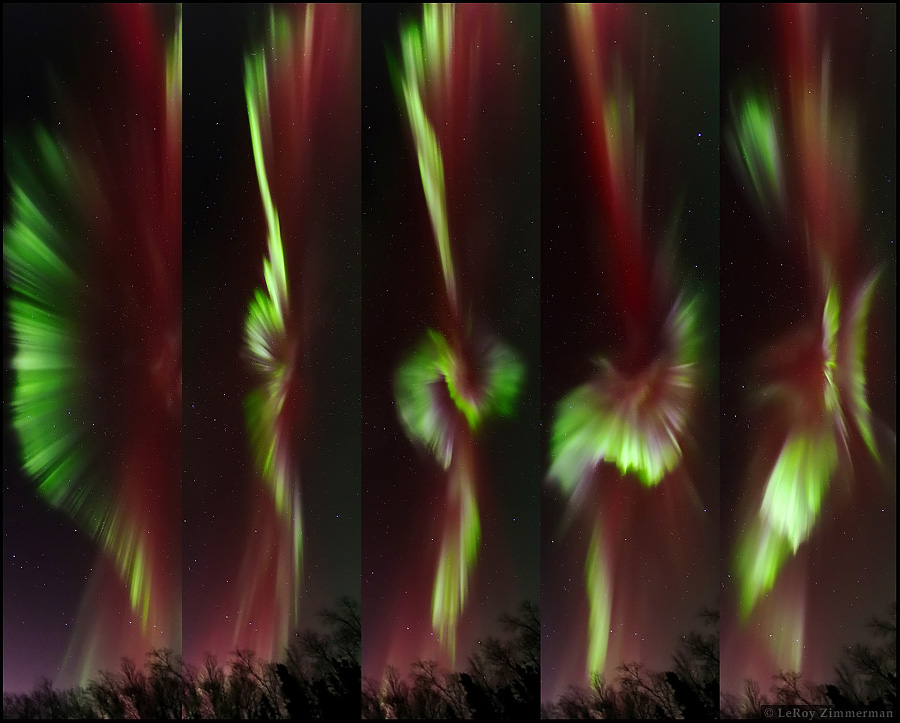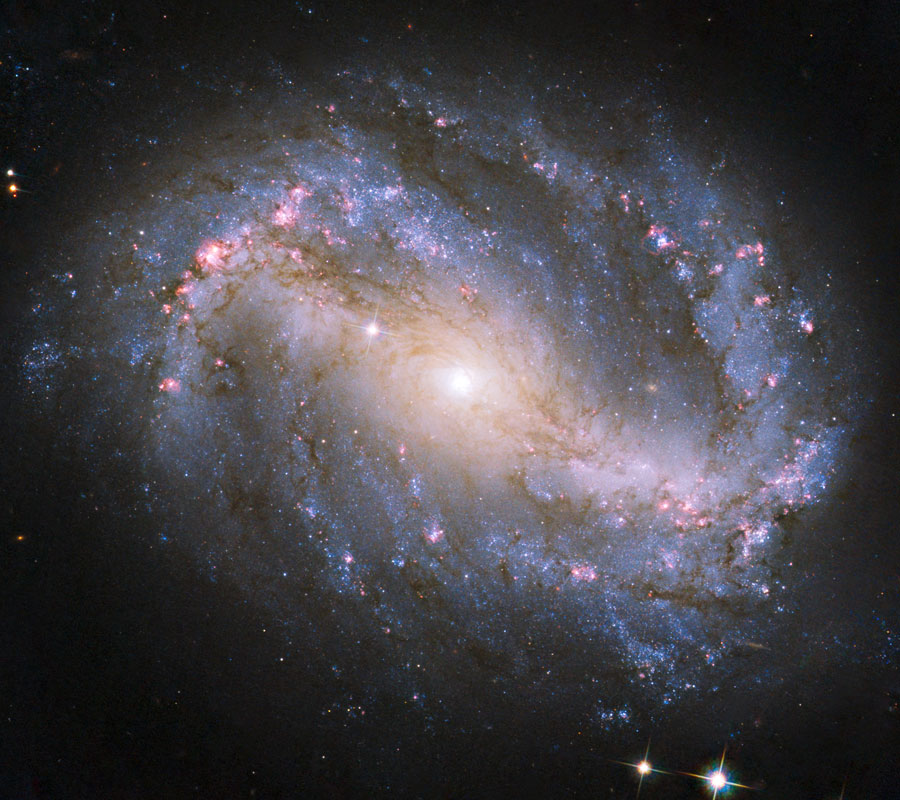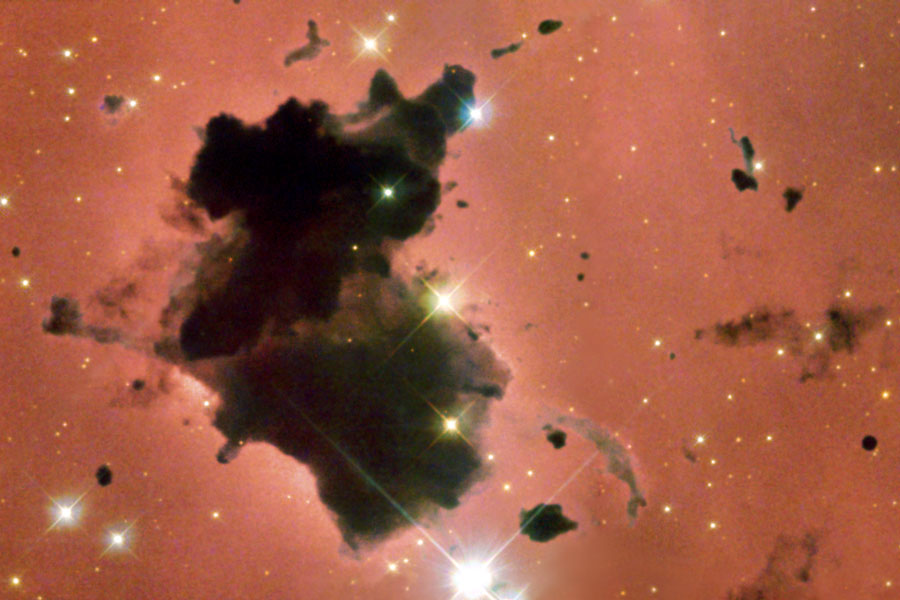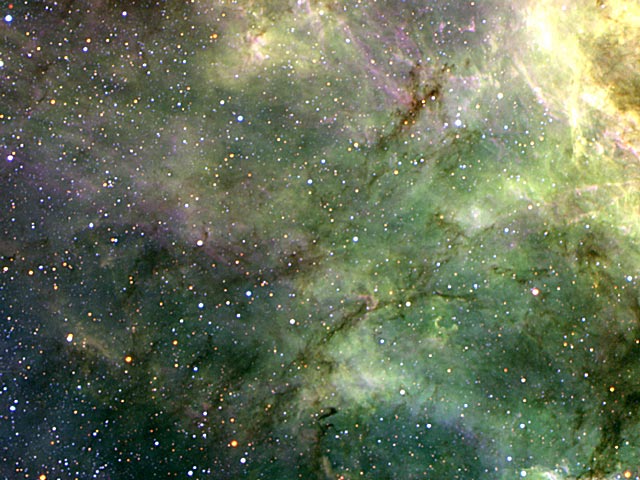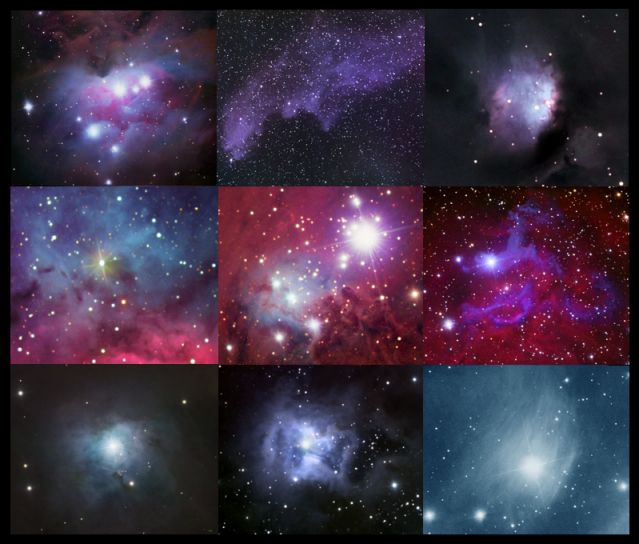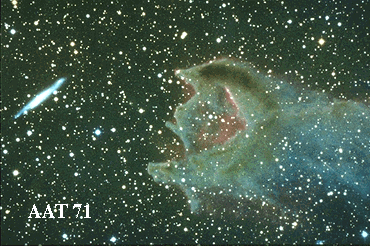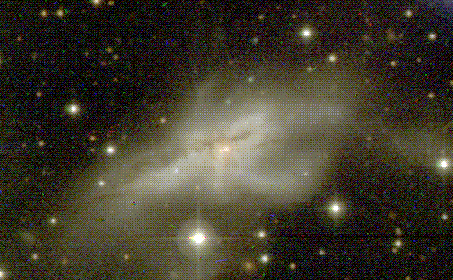| << Previous | Index | Next >> |
2014 What's happening over that town? Close inspection shows these strange columns of light occur over bright lights, and so likely are light pillars that involve falling ice crystals reflecting back these lights. The above image and several similar images were taken with a standard digital camera in Sigulda, Latvia in late 2009. The reason why these pillars fan out at the top, however, remains a topic for speculation. The air was noted to be quite cold and indeed filled with small ice crystals, just the type known to create several awe-inspiring but well known sky phenomena such as light pillars, sun pillars, sun dogs, and moon halos. The cold and snowy winter occurring this year in parts of Earth's northern hemisphere is giving sky enthusiasts new and typically unexpected opportunities to see several of these unusual optical atmospheric phenomena for themselves.
2013 A remarkably intense auroral band flooded the northern night with shimmering colors on December 7. The stunning sequence captured here was made with a camera fixed to a tripod under cold, clear skies near Ester, just outside of Fairbanks, Alaska. Left to right, spanning a period of about 30 minutes, the panels follow changes in the dancing curtains of northern lights extending to altitudes of over 100 kilometers in a band arcing directly overhead. The panels span 150 degrees vertically, covering about 500 kilometers of aurora laying across the sky from edge to edge. The auroral activity was triggered by a moderate level geomagnetic storm, as a high speed solar wind stream buffeted planet Earth's magnetosphere.
2012 Fantastic shapes lurk in clouds of glowing hydrogen gas in NGC 6188, about 4,000 light-years away. The emission nebula is found near the edge of a large molecular cloud unseen at visible wavelengths, in the southern constellation Ara. Massive, young stars of the embedded Ara OB1 association were formed in that region only a few million years ago, sculpting the dark shapes and powering the nebular glow with stellar winds and intense ultraviolet radiation. The recent star formation itself was likely triggered by winds and supernova explosions, from previous generations of massive stars, that swept up and compressed the molecular gas. Joining NGC 6188 on this cosmic canvas is rare emission nebula NGC 6164, also created by one of the region's massive O-type stars. Similar in appearance to many planetary nebulae, NGC 6164's striking, symmetric gaseous shroud and faint halo surround its bright central star at the lower right. The field of view spans about two full Moons, corresponding to 70 light years at the estimated distance of NGC 6188.
2011 Comet Lovejoy (C/2011 W3) survived its close encounter with the Sun earlier this month, taking its place among wonders of the southern skies just in time for Christmas. Seen here before sunrise from Paranal Observatory in Chile, the sungrazing comet's tails stretch far above the eastern horizon. Spanning over 20 degrees they rise alongside the plane of the our Milky Way galaxy. A breathtaking spectacle in itself, Lovejoy performs on this celestial stage with southern stars and nebulae, including the Large and Small Magellanic clouds right of the telescope dome, and the glow of zodiacal light along the left edge of the frame. With Paranal's Very Large Telescope units in the foreground, this wide-angle scene was captured on December 23. Receding from the Sun, Comet Lovejoy's tails have continued to grow in length even as the comet fades.
2010
[imghover6=http://apod.nasa.gov/apod/image/1012/sk ... _tezel.jpg]http://apod.nasa.gov/apod/image/1012/sk ... otated.jpg[/imghover6]Credit & Copyright: Tunç Tezel (TWAN)
2009 Many spiral galaxies have bars across their centers. Even our own Milky Way Galaxy is thought to have a modest central bar. Prominently barred spiral galaxy NGC 6217, pictured above, was captured in spectacular detail in this recently released image taken by the newly repaired Advanced Camera for Surveys on the orbiting Hubble Space Telescope. Visible are dark filamentary dust lanes, young clusters of bright blue stars, red emission nebulas of glowing hydrogen gas, a long bright bar of stars across the center, and a bright active nucleus that likely houses a supermassive black hole. Light takes about 60 million years to reach us from NGC 6217, which spans about 30,000 light years across and can be found toward the constellation of the Little Bear (Ursa Minor).
2008 Rich star fields and glowing hydrogen gas silhouette dense, opaque clouds of interstellar gas and dust in this Hubble Space Telescope close-up of IC 2944, a bright star forming region in Centaurus, 5,900 light-years away. The largest of these dark globules, first spotted by South African astronomer A. D. Thackeray in 1950, is likely two separate but overlapping clouds, each more than one light-year wide. Combined the clouds contain material equivalent to about 15 times the mass of the Sun, but will they actually collapse to form massive stars? Along with other data, the sharp Hubble images indicate that Thackeray's globules are fractured and churning as a result of intense ultraviolet radiation from young, hot stars already energizing and heating the bright emission nebula. These and similar dark globules known to be associated with other star forming regions may ultimately be dissipated by their hostile environment -- like cosmic lumps of butter in a hot frying pan.
2007 This symmetric cloud dubbed the Boomerang Nebula was created by a high-speed wind of gas and dust blowing from an aging central star at speeds of nearly 600,000 kilometers per hour. The rapid expansion has cooled molecules in the nebular gas to about one degree above absolute zero - colder than even the cosmic background radiation - making it the coldest known region in the distant Universe. Shining with light from the central star reflected by dust, the frigid Boomerang Nebula is believed to be a star or stellar system evolving toward the planetary nebula phase. This Hubble image was recorded using polarizing filters (analogous to polaroid sunglasses) and color coded by the angle associated with the polarized light. The gorgeous result traces the small dust particles responsible for polarizing and scattering the light. The Boomerang Nebula spans about one light year and lies about 5,000 light years away toward the constellation Centaurus.
2006 The Great Spiral Galaxy in Andromeda (aka M31), a mere 2.5 million light-years distant, is the closest large spiral to our own Milky Way. Andromeda is visible to the unaided eye as a small, faint, fuzzy patch, but because its surface brightness is so low, casual skygazers can't appreciate the galaxy's impressive extent in planet Earth's sky. This entertaining composite image compares the angular size of the nearby galaxy to a brighter, more familiar celestial sight. In it, a deep exposure of Andromeda, tracing beautiful blue star clusters in spiral arms far beyond the bright yellow core, is combined with a typical view of a nearly full Moon. Shown at the same angular scale, the Moon covers about 1/2 degree on the sky, while the galaxy is clearly several times that size. The deep Andromeda exposure also includes two bright satellite galaxies, M32 and M110 (bottom).
2005 Why are parts of this asteroid's surface so smooth? No one is yet sure, but it may have to do with the dynamics of an asteroid that is a loose pile of rubble rather than a solid rock. The unusual asteroid is currently being visited by the Japanese spacecraft Hayabusa that is documenting its unusual structure and mysterious lack of craters. Last month, Hayabusa actually touched down on one of the smooth patches, dubbed the MUSES Sea, and collected soil samples that will eventually be returned to Earth for analysis. Unfortunately, the robot Hayabusa craft has been experiencing communications problems and so its departure for Earth has been delayed until 2007. Computer simulations show that 500-meter asteroid Itokawa may impact the Earth within the next few million years.
2004 The Tarantula Nebula is a giant emission nebula within our neighboring galaxy the Large Magellanic Cloud. Inside this cosmic arachnid lies a huge central young cluster of massive stars, cataloged as R136 and partially visible on the upper right. The energetic light and winds from this cluster light up the nebula and sculpt the surrounding gas and dust into vast complex filaments. These "tentacles" give the Tarantula Nebula its name. In this impressive color image from the Wide-Field Imager camera on ESO's 2.2-meter telescope at La Silla Observatory, intricacies of the nebula's complex array of dust and gas are visible. A 300 light-year portion of the Tarantula Nebula is imaged. The Tarantula Nebula, also dubbed 30 Doradus, lies 170,000 light years away toward the constellation of Dorado.
2003 Dust pillars are like interstellar mountains. They survive because they are more dense than their surroundings, but they are being slowly eroded away by a hostile environment. Visible in the above picture is the end of a huge gas and dust pillar in the Trifid Nebula, punctuated by a smaller pillar pointing up and an unusual jet pointing to the left. The pink dots are newly formed low-mass stars. A star near the small pillar's end is slowly being stripped of its accreting gas by radiation from a tremendously brighter star situated off the above picture to the upper right. The jet extends nearly a light-year and would not be visible without external illumination. As gas and dust evaporate from the pillars, the hidden stellar source of this jet will likely be uncovered, possibly over the next 20,000 years.
2002 This dream-like image of Mir was recorded by astronauts as the Space Shuttle Atlantis approached the Russian space station prior to docking during the STS-76 mission. Sporting spindly appendages and solar panels, Mir resembles a whimsical flying insect hovering about 350 kilometers above New Zealand's South Island and the city of Nelson near Cook Strait. In late March 1996, Atlantis shuttled astronaut Shannon W. Lucid to Mir for a five month visit, increasing Mir's occupancy from 2 to 3. It returned to pick Lucid up and drop off astronaut John Blaha during the STS-79 mission in August of that year. Since becoming operational in 1986, Mir has been visited by over 100 spacefarers from the nations of planet Earth including, Russia, the United States, Great Britain, Germany, France, Japan, Austria, Kazakhstan and Slovakia. After joint Shuttle-Mir training missions in support of the International Space Station, continuous occupation of Mir ended in August 1999. The Mir was deorbited in March 2001.
2001 Interstellar dust grains often find themselves in a reflective "mood". Near a bright star, clouds of these dust particles scatter short wavelengths of visible starlight more readily than long wavelengths, producing lovely blue reflection nebulae. Nine of the more spectacular examples of these dusty, blue stellar neighborhoods have been assembled here by astrophotographer Rob Gendler. From left to right starting with the top row are NGC 1977 in Orion, IC2118 (the Witch Head), and M78 also in Orion. Across the middle row are, M20 (Trifid), NGC 2264 in Monoceros, and IC405 (Flaming Star Nebula). Along the bottom are NGC 2023 (near the Horsehead), NGC 7023 (Iris Nebula), and finally bright star Merope surrounded by a veil of dust (NGC 1435). Merope is one of the seven sisters of the Pleiades.
2000 This arresting image of the third quarter moon in the excellent skies above the Pine Crest Farm Observatory, Dell Prairie, Wisconsin, was recorded with a 24 inch telescope and digital camera on October 19. Marvelously detailed, especially along the terminator or shadow line between lunar night and day, this cropped version of the full mosaicked image shows the cratered north polar region (top) and the broad smooth Mare Imbrium. Notable at the northern edge of the Mare Imbrium (Sea of Rains) is the 95 kilometer wide dark crater Plato, while the dramatic straight "cut" to the right of Plato, (toward the terminator) is the Vallis Alpes (Alpine Valley). The long, graceful arc of the lunar Montes Apenninus (Apennine Mountains) in the lower portion of the image sweeps southward along the boundary of the mare toward the left and ends near the bright ray crater Copernicus at the picture's edge. In 1971, Apollo 15 landed near the gap beyond the opposite (northern) end of the Montes Apenninus arc.
1999 Fittingly, 1999 saw a decade of astronomical discoveries to an end with portents of things to come - embodied in new spacecraft, telescopes, and perspectives to explore the distant Universe across the electromagnetic spectrum. X-ray astronomy in particular will likely flourish in coming years, judging from this year's successful launch of the triple-barrelled X-ray Multi-Mirror satellite and spectacular first results from the orbiting Chandra X-ray Observatory. Ground-based astronomy will flourished too as very large telescopes and new instruments have come online or near completion. Radio astronomers also achieved an observational milestone this year with the record breaking VLBI observations from a network of radio telescopes as large as planet Earth. But the APOD editors' favorite astronomical screensaver of 1999 has leveraged the phenomenonal growth of the internet and the personal computer boom to support the Search for ExtraTerrestrial Intelligence in the SETI@home project - which has now likely involved more computer power than any other project in history.
1998 On December 23, the NEAR spacecraft flew by asteroid 433 Eros. NEAR was originally scheduled to brake and orbit Eros, but an unexpected shutdown of its main engine caused this plan to be aborted. NEAR will now be reset and attempt to return to orbit Eros in early 2000. The above image sequence was taken as NEAR approached Eros. The rotation of the asteroid is visible in the successive frames. When NEAR is fully operational, it will likely provoke the world's largest telescopes to point not toward asteroid Eros but to positions indicated by another of NEAR's instruments: its gamma-ray burst (GRB) detector. NEAR's distant GRB detector happens now to be in a unique position to contribute information crucial to the rapid acquisition of accurate GRB positions.
1997 The Hubble Space Telescope imaged Pluto and its moon Charon in 1994. Pluto is usually the most distant planet from the Sun but because of its elliptic orbit Pluto crossed inside of Neptune's orbit in 1979 and will cross back out again in 1999. Compared to the other planets, very little is known about Pluto. Pluto is smaller than any other planet and even smaller than several other planet's moons. From Pluto, the Sun is just a tiny point of light. Pluto is probably composed of frozen rock and ice, much like Neptune's moon Triton. Pluto has not yet been visited by a spacecraft, but a mission is being planned for the next decade.
1996 The odd looking "creature" to the right of center in the above photo is a gas cloud known as a cometary globule. This globule, however, has ruptured. Cometary globules are typically characterized by dusty heads and elongated tails. These features cause cometary globules to have visual similarities to comets, but in reality they are very much different. Cometary globules are frequently the birthplaces of stars, and many show very young stars in their heads. The reason for the rupture in the head of this object is not completely known. The galaxy to the left of center is very far in the distance and is only placed near CG4 by chance superposition.
1995 Sometimes even galaxies can suffer a fatal attraction. Here gravity causes two galaxies to collide in a spectacular display of energetic gas, dust, and light. When galaxies collide it is rare that any stars in the galaxies themselves collide, or that any change will be seen in a human lifetime. Rather the structure of one or both galaxies gets slowly disrupted, while interior gas condenses to new star forming regions. Stellar motions in the center of the NGC 6240 frenetic mix are among the highest in any stellar system. Galaxy mergers may emit energetic radiations across the electromagnetic spectrum. This galactic jumble is, in fact, extremely bright in infrared light.
| << Previous | Index | Next >> |

